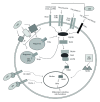Pattern recognition receptors and cytokines in Mycobacterium tuberculosis infection--the double-edged sword?
- PMID: 24350246
- PMCID: PMC3844256
- DOI: 10.1155/2013/179174
Pattern recognition receptors and cytokines in Mycobacterium tuberculosis infection--the double-edged sword?
Abstract
Tuberculosis, an infectious disease caused by Mycobacterium tuberculosis (Mtb), remains a major cause of human death worldwide. Innate immunity provides host defense against Mtb. Phagocytosis, characterized by recognition of Mtb by macrophages and dendritic cells (DCs), is the first step of the innate immune defense mechanism. The recognition of Mtb is mediated by pattern recognition receptors (PRRs), expressed on innate immune cells, including toll-like receptors (TLRs), complement receptors, nucleotide oligomerization domain like receptors, dendritic cell-specific intercellular adhesion molecule grabbing nonintegrin (DC-SIGN), mannose receptors, CD14 receptors, scavenger receptors, and FCγ receptors. Interaction of mycobacterial ligands with PRRs leads macrophages and DCs to secrete selected cytokines, which in turn induce interferon-γ- (IFNγ-) dominated immunity. IFNγ and other cytokines like tumor necrosis factor-α (TNFα) regulate mycobacterial growth, granuloma formation, and initiation of the adaptive immune response to Mtb and finally provide protection to the host. However, Mtb can evade destruction by antimicrobial defense mechanisms of the innate immune system as some components of the system may promote survival of the bacteria in these cells and facilitate pathogenesis. Thus, although innate immunity components generally play a protective role against Mtb, they may also facilitate Mtb survival. The involvement of selected PRRs and cytokines on these seemingly contradictory roles is discussed.
Figures


References
-
- World Health Organization. Global tuberculosis control. 2010.
-
- Korbel DS, Schneider BE, Schaible UE. Innate immunity in tuberculosis: myths and truth. Microbes and Infection. 2008;10(9):995–1004. - PubMed
-
- Medzhitov R, Janeway CJ., Jr. The Toll receptor family and microbial recognition. Trends in Microbiology. 2000;8(10):452–456. - PubMed
-
- Kaisho T, Akira S. Critical roles of Toll-like receptors in host defense. Critical Reviews in Immunology. 2000;20(5):393–405. - PubMed
Publication types
MeSH terms
Substances
LinkOut - more resources
Full Text Sources
Other Literature Sources
Medical
Research Materials

